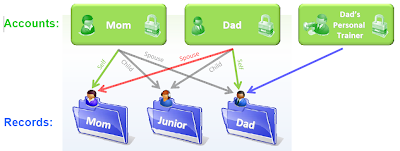Steve Shihadeh, VP, Health Solutions Group, Microsoft Corp.
Clyde Wesp, MD, FAAP, CMO, St. Joseph Health System
Today's Steve, like yesterday's Steve, compared HealthVault to PayPay, in the sense that "no one goes to the PayPal website...they go to eBay or Barnes and Noble..." I'm not sure that's quite accurate--PayPal was, in the early days, just a way to send money to send money to friends and family, and perhaps eBay sellers, instead of mailing a check. Once that business model was successful, online merchants jumped on the bandwagon.
In the case of HealthVault, Microsoft is hoping that vendors, hospitals, and insurance carriers jump on the bandwagon in a leap of faith that other vendors, hospitals and insurance carriers will follow suit.
As I've mentioned before, Google is taking more of a consumer-focused approach, much closer to PayPal's approach than HealthVault's.
Also, PayPal generates its revenue from transation fees. Microsoft claims that theirs is an advertising-based revenue model.
Another difference is that, for the most part, PayPal isn't a central storage facility for...well, anything. They do offer the ability to store cash in a money market account and then use that cash for future transactions, but many PayPal users (myself included) never store any cash in their PayPal accounts. Transactions pull money directly from the user's checking account or credit card to the merchant's account.
But I see what the Steves are saying. There is a need for a central clearinghouse for healthcare information, and it makes perfect sense that the patient should have control over the distribution of his/her information...even if (or especially if) they aren't fully aware of the control that they have (like they would if they were carrying around a PHR on a smart card or flash drive).
 Click here for full presentation
Click here for full presentation
Great Healthcare via Unified Communications: A Developer's Perspective (Developer Track)
Chris D. Mayo, Technology Evangelist for the Unified Communications Platform, Microsoft Corp.

It should be news to no one that Microsoft would like to have all of their products fully entrenched in every company in the world. That's obviously not going to happen, since different IT shops have different platform expertise. But for companies that are already on the Microsoft bandwagon, it makes sense to at least explore Microsoft's offerings and, in the case of communications, consider Microsoft's Unified Communications platform as a replacement for traditional PBXs (or even newer IP-based telephony systems).
From a software engineering perspective, Microsoft has provided a wealth of tools (Web services, drag-and-drop WFC controls, etc.) to make it really easy to build UC features into apps.
Cross Enterprise Document Sharing (XDS.b) Reference Implementation (Developer Track)
Mark Simmons, Health Consultant, SIMPL
Wagner Silveira, Microsoft Technical Architect, Microsoft Corp.
This was an interesting discussion of the SIMPL/Microsoft approach to IHE...not highly relevant to AdvancedMD right now, because we're not pursuing IHE implementation at this point. Another opportunity to catch up on e-mails.
Better User Experience in Clinical Applications (Developer Track)
Anand Gaddum, Director, Healthcare Practice, iLink Systems
William Hughes, Director, Product Innovation, GE Heatlhcare Enterprise IT Solutions Division
Anand and William demo'd a prototype application built on Silverlight. It was very impressive, and only took a team of 5 full- and part-time engineers about 2 1/2 months to build...but it clearly wasn't ready for prime-time.
Still, it reinforces my believe that Silverlight will be a powerful development platform as it matures, and as the runtime becomes more ubiquitous.
In particular, as we try to encourage doctors to adopt new technology, Silverlight provides UI "eye candy" that might help pique their interest.
Building Safer Healthcare Applications in WPF and Silverlight with the Microsoft Health Common User Interface (Developer Track)
Andrew Kirby, Director in Microsoft Services UK, Microsoft Corp.
MSCUI was launched a year ago at the last Tech Forum in Redmond. This session was an overview of MSCUI and a view into how it's been adopted over the past year.
This is a really interesting project, because it isn't a sellable product, or even an initiative that directly results in the sale of Microsoft technology. It's a collection of design guidelines that are totally platform agnostic, as well as a collection of free controls that illustrate the principles of the guidelines using Microsoft technology.
Obviously, one of Microsoft's objectives is to provide enough free controls and other shortcuts using their technology that healthcare organizations will be encouranged to use Microsoft tools to create solutions, so it isn't a purely altruistic endeavor, but it's pretty cool, anyway.
There is a ton of information available at http://www.mscui.net/, so I won't dive in any deeper here.
Surface Technology in Healthcare (Closing Keynote)
Randy Fusco, CTO & Strategist, Microsoft U.S. Healthcare Provider Solutions, Microsoft Corp.
This was a pretty exciting session. Surface started out as an informal collaboration between a couple of departments at Microsoft back in 2001. A few years ago, it was officially funded as a research project by Microsoft, and now it is an actual product.
It's difficult to describe how cool this stuff is without actually seeing it. If you're interested, check out the Microsoft Surface website.




